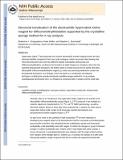| dc.contributor.author | Vinogradova, Ekaterina V. | |
| dc.contributor.author | Mueller, Peter | |
| dc.contributor.author | Buchwald, Stephen Leffler | |
| dc.date.accessioned | 2015-11-03T13:02:06Z | |
| dc.date.available | 2015-11-03T13:02:06Z | |
| dc.date.issued | 2014-02 | |
| dc.date.submitted | 2013-12 | |
| dc.identifier.issn | 14337851 | |
| dc.identifier.issn | 1521-3773 | |
| dc.identifier.uri | http://hdl.handle.net/1721.1/99674 | |
| dc.description.abstract | Hypervalent iodine λ[superscript 3]-benziodoxoles are common electrophilic transfer reagents known for their enhanced stability compared to their non-cyclic analogues. Herein we present data showing that chlorobenziodoxole reacts with two different thiolate nucleophiles (thiocyanate and trifluoromethylthiolate), resulting in the formation of stable thioperoxy complexes rather than the expected benziodoxole derivatives. We further report a revised structure for the earlier described electrophilic trifluoromethylthiolation reagent (1), which was previously believed to contain the benziodoxole framework. Our findings, which are based on a combination of analytical techniques, including the recently introduced crystalline sponge method for X-ray analysis, unambiguously demonstrate that 1 is a thioperoxy compound both in solution and the solid state. | en_US |
| dc.description.sponsorship | National Institutes of Health (U.S.) (Award GM58160) | en_US |
| dc.language.iso | en_US | |
| dc.publisher | Wiley Blackwell | en_US |
| dc.relation.isversionof | http://dx.doi.org/10.1002/anie.201310897 | en_US |
| dc.rights | Creative Commons Attribution-Noncommercial-Share Alike | en_US |
| dc.rights.uri | http://creativecommons.org/licenses/by-nc-sa/4.0/ | en_US |
| dc.source | PMC | en_US |
| dc.title | Structural Reevaluation of the Electrophilic Hypervalent Iodine Reagent for Trifluoromethylthiolation Supported by the Crystalline Sponge Method for X-ray Analysis | en_US |
| dc.type | Article | en_US |
| dc.identifier.citation | Vinogradova, Ekaterina V., Peter Muller, and Stephen L. Buchwald. “Structural Reevaluation of the Electrophilic Hypervalent Iodine Reagent for Trifluoromethylthiolation Supported by the Crystalline Sponge Method for X-Ray Analysis.” Angew. Chem. Int. Ed. 53, no. 12 (February 14, 2014): 3125–3128. | en_US |
| dc.contributor.department | Massachusetts Institute of Technology. Department of Chemistry | en_US |
| dc.contributor.mitauthor | Vinogradova, Ekaterina V. | en_US |
| dc.contributor.mitauthor | Mueller, Peter | en_US |
| dc.contributor.mitauthor | Buchwald, Stephen Leffler | en_US |
| dc.relation.journal | Angewandte Chemie International Edition | en_US |
| dc.eprint.version | Author's final manuscript | en_US |
| dc.type.uri | http://purl.org/eprint/type/JournalArticle | en_US |
| eprint.status | http://purl.org/eprint/status/PeerReviewed | en_US |
| dspace.orderedauthors | Vinogradova, Ekaterina V.; Muller, Peter; Buchwald, Stephen L. | en_US |
| dc.identifier.orcid | https://orcid.org/0000-0003-3875-4775 | |
| mit.license | OPEN_ACCESS_POLICY | en_US |
| mit.metadata.status | Complete | |
